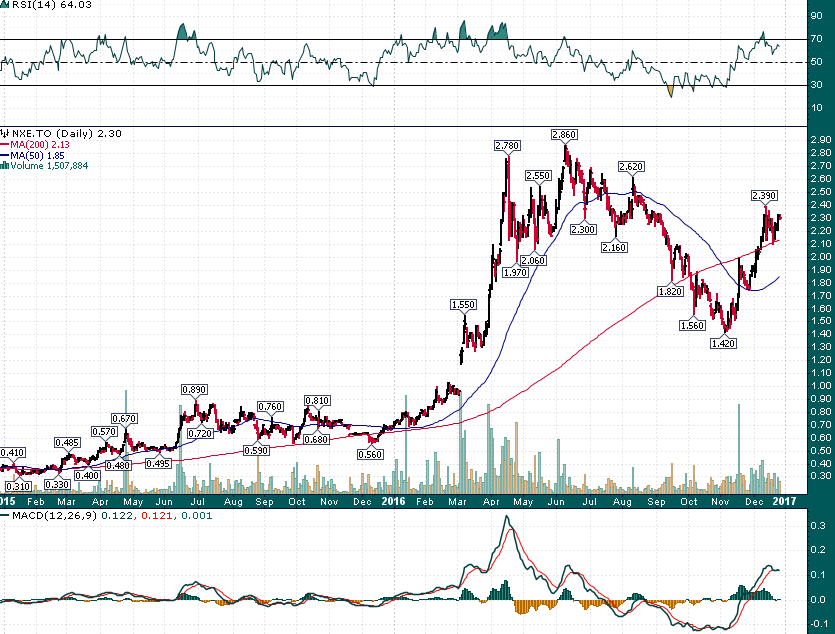In a little followed– highly volatile niche of the stock market – public venture capital investing, CEO.ca has become an invaluable web site to crowdsource due diligence and discuss speculative investment ideas.
The site was founded in 2012 by Vancouver-entrepreneur Tommy Humphreys as a blog about Canada’s top investors and morphed into a chat application in early 2015, allowing its users to chat and share articles about their ideas.
Tommy Humphreys, CEO.ca Founder
Some of the Canadian stock market’s biggest success stories of late have unfolded on CEO.ca — like NexGen Energy (NXE.TO), which discovered arguably the richest uranium deposit ever, while its shares soared from $0.30 to nearly $3.00 before gaining backing from Hong Kong’s richest man, Li Ka Shing. CEO.ca was bullish on the company early, and was the first platform to publish a site visit report (http://blog.ceo.ca/2014/08/21/nexgen-energy-site-visit-all-signs-point-to-arrow/). Later, Humphreys interviewed the company’s largest hedge fund holder (http://blog.ceo.ca/2015/10/28/rosseaus-warren-irwin-shorted-bre-x-now-he-s-going-long-nexgen/), and the former Chief Mine Engineer of Canada’s largest uranium miner (http://blog.ceo.ca/2015/11/25/camecos-former-chief-mine-engineer-on-why-hes-long-nexgen/) to explain the significance of NexGen’s new discovery.
NXE.TO (Daily – 2 Year)
As the rest of the world caught on, CEO.ca subscribers literally made millions (https://ceo.ca/index?f656f9481cf8). The NXE channel at ceo.ca/NXE continues to provide a vibrant daily conversation on the outlook for NexGen and Uranium.
Lithium X Energy (LIX.V) is another CEO.ca success story. Humphreys introduced it to CEO.ca readers at $0.15 in October 2015 (http://blog.ceo.ca/2015/10/06/fuelling-tesla-millennial-mining-legend-join-forces-in-nevada-lithium-rush/) and shares reached $2.85 by April 2016.
Humphreys — along with a cadre of CEO.ca regulars consisting of both retail and professional investors — pounded the table for dozens of early stage miners that went on to increase in value over 500% over the past year as the four year bear market in commodities ended.
Popular CEO.ca stocks, and those featured by Humphreys, are some of the investing world’s most volatile, and exciting.
Massive Alaskan copper-gold-moly deposit Northern Dynasty Minerals (AMEX: NAK, TSX-V: NDM) was north of $20/share in 2011 and CEO.ca readers were alerted to this idea under $0.33 in Summer 2015 http://blog.ceo.ca/2015/08/13/giustra-keep-northern-dynasty-deal/. Shares are back up above $2.50 today on Trump bullishness.
CanAlaska Uranium (CVV.V) moved from $0.12 to $1.50 in the first 8 months of 2016, and is currently on its way back down after disappointing diamond exploration results. https://youtu.be/EkwGYs6X-II
Sabina Gold and Silver (SBB.TO) rallied from $0.35 past $1.75 last year on a new CEO and rising gold prices, but has stumbled below $1 recently on permitting issues. http://blog.ceo.ca/2015/10/02/sabina-gold-silver-back-river-bruce-mcleod-ceo/
Cordoba Minerals (CDB.V) was profiled at $0.10 and jumped to $0.90+ following investment from mining legend Robert Friedland and is still going strong. http://blog.ceo.ca/2015/02/10/mario-stifano-cordoba-minerals-drills-colombias-next-copper-gold-porphyry-belt/
To quote Humphreys, “2016 was the year we were waiting for.”
I caught up with Tommy over the Christmas holiday to get his take on the resource market and CEO.ca.
CEO Technician: What did you learn in 2016 both as an investor and as an entrepreneur?
Tommy Humphreys: In 2016 you didn’t have to be smart, just long, to have a great year. Simply put, I basically had a five year plan where I wanted to be long this space when it turned and it finally turned this year and it was worth waiting for. Part patience, part dumb luck, and extreme risk tolerance.
Some of the hard lessons learned in previous years helped in 2016, like appropriate position sizing. One of my mentors advised me to always “get your bait back” when the market affords you the chance – take some money off the table. During the summer some of my positions became worth real money, and I took advantage of the liquidity in the market to take some profits and diversify a bit into some lower risk investments. This worked out well as the resource market has cooled off to close out the year.
CEO Technician: What do you think of the market right here and do you think it’s time to begin accumulating again?
Tommy Humphreys: I am not smart enough to know where the gold market is headed — and gold drives most of this sector. But I do know that sentiment has turned from bullish in the summer to despair again. In many cases stock prices have come down 50% since Trump’s election. I’ve had quite a few bids get hit in the last couple of weeks, bids that I didn’t think would get hit. I plan to bet what I can afford to lose in names I know well that have come off. I’m buying in private placements, with sweeteners attached like warrants, as well as in the market when it’s an asset I like.
I still think we’re early in the resurgence in the resource sector; we are seeing signs of a turn in uranium and there’s an article on the Bloomberg home page about gold miners running out of metal https://www.bloomberg.com/news/articles/2016-12-21/gold-miners-are-running-out-of-metal-five-charts-explaining-why. People are beginning to be receptive to pro-commodity themes and there’s a scarcity of good assets.
The amazing thing about the junior sector is that asymmetric returns are possible for those who can stomach the risks. You can become a millionaire on two trades, starting with ten grand. A ten bagger on ten grand is a hundred grand, and a ten bagger on a hundred is a million. Rob Hirschberg’s story illustrates this: https://youtu.be/hu0kcB5gVL8
CEO Technician: Tell me some more about the resource sector and what you’ve learned about how cycles evolve.
Tommy Humphreys: The venture market is relatively straightforward. You have a few very high quality discoveries that have seen tremendous amounts of capital invested to de-risk them, as well as good luck. These take many years to unfold. NexGen’s Arrow deposit is an example of this and it will get taken out. That’s the rare success story.
For every NexGen there’s dozens of ‘me too’ companies whose management teams earn a good living merely looking for the next potential strike. These companies tend to have the biggest marketing budgets, and frankly distract investors from the best quality deposits. Most of these plays don’t ultimately work out, but without them, there are no NexGens.
The resource space is more subject to macro themes than other sectors. For example, this year companies that didn’t even have a good project still returned 400-500% from the lows to the peak. Nothing changed in their business or the quality of their projects. The only thing that changed was the market’s perception of the sector they are in. People are always paying up today for the potential of something big tomorrow, so I want to pay as little today to get exposed to potential in the future.
CEO Technician: What is the biggest mistake that an investor can make in the resource sector?
Tommy Humphreys: Emotional purchases, and inappropriate (too large) position sizing.
The first time I ever flew on a private jet (it was a tiny cigarette sized plane with a hilarious bathroom that would make you miss commercial airlines) a famous mining entrepreneur on the flight was raving about a copper junior’s drill results. When the plane landed I bet a huge chunk of my then investable assets on the deal. Classic mistake. The market was already frothy when I bought (2011) and It turned out to be a 75% loss in six months.
Junior stocks also tend to be incredibly volatile, and have massive price swings throughout the year. The smart speculator takes time to buy and sell positions, to get a better average cost, and always has some dry powder around to take advantage of panic selling in the market, which happens from time to time.
CEO Technician: Tell us about CEO.ca and how has your business model and the site’s traffic evolved throughout the year?
Tommy Humphreys: CEO.ca is a dream business for me. I am really excited to be working on a mobile investor product to help people get better faster information.
CEO.ca continues to be subsidized by advertising. We have about the same sized advertising business we had last year and the year before, but the traffic and time spent on the site is up over 600% thanks to a rising market and community content. I would like to be selling more sponsorships, but our small team can only do so many things well, and right now we are more focused on the web product.
We are constantly experimenting. For example, in mid-year we stopped providing an ongoing free publication. It was taking a big chunk of the budget but providing a small fraction of the traffic. Few users complained and traffic has doubled since, which surprised me. I would like to invest more in content and research, but would like a better economic case to do so.
Our focus in 2017 will again be on the product. We want to build the best possible mobile stock market watchlist, with even better data and news feeds and of course, chat. We want to better help people identify quality users and ideas. I’ve been saying for months that we are about to introduce a CEO.CA pro service, and we are. ASAP!
And I’ll continue to seek knowledge and compelling investment and speculation opportunities and will share what I learn with the CEO.ca community.
CEO Technician: What are you feeling bullish about going into 2017?
Tommy Humphreys: I am bullish on DIY (do it yourself) investing and the role of web interfaces to make the experience better. That’s why I keep doubling down on CEO.ca and Spiel, our platform. As far as stock ideas, Continental Gold $CNL, which I have an interest in, is very attractively priced under $3.75, in my personal opinion (not investment advice). The sector needs grade and growth, and companies like CNL are going to deliver, so I want to be there.
CNL.TO (Daily – 2 year)
CEO Technician: From a technical perspective the CNL chart is very interesting with a multi-month consolidation underway between ~$3.10 and ~$4.69 – a breakout above $4.70 would target $7+, whereas a breakdown below $3.10 would be bad news.
I certainly learned a lot from this conversation and I would like to thank Tommy for the interview. 2017 looks to be an exciting year for the resource sector and for CEO.ca! Go to CEO.ca for a free account.
DISCLAIMER: The work included in this article is based on SEDAR filings, current events, interviews, and corporate press releases. It may contain errors, and you shouldn’t make any investment decision based solely on what you read here. This publication contains forward-looking statements, including but not limited to comments regarding predictions and projections. Forward-looking statements address future events and conditions and therefore involve inherent risks and uncertainties. Actual results may differ materially from those currently anticipated in such statements. The views expressed in this publication and on the EnergyandGold website do not necessarily reflect the views of Energy and Gold Publishing LTD, publisher of EnergyandGold.com. This publication is provided for informational and entertainment purposes only and is not a recommendation to buy or sell any security. Always thoroughly do your own due diligence and talk to a licensed investment adviser prior to making any investment decisions. Junior resource companies can easily lose 100% of their value so read company profiles on www.SEDAR.com for important risk disclosures. It’s your money and your responsibility.



